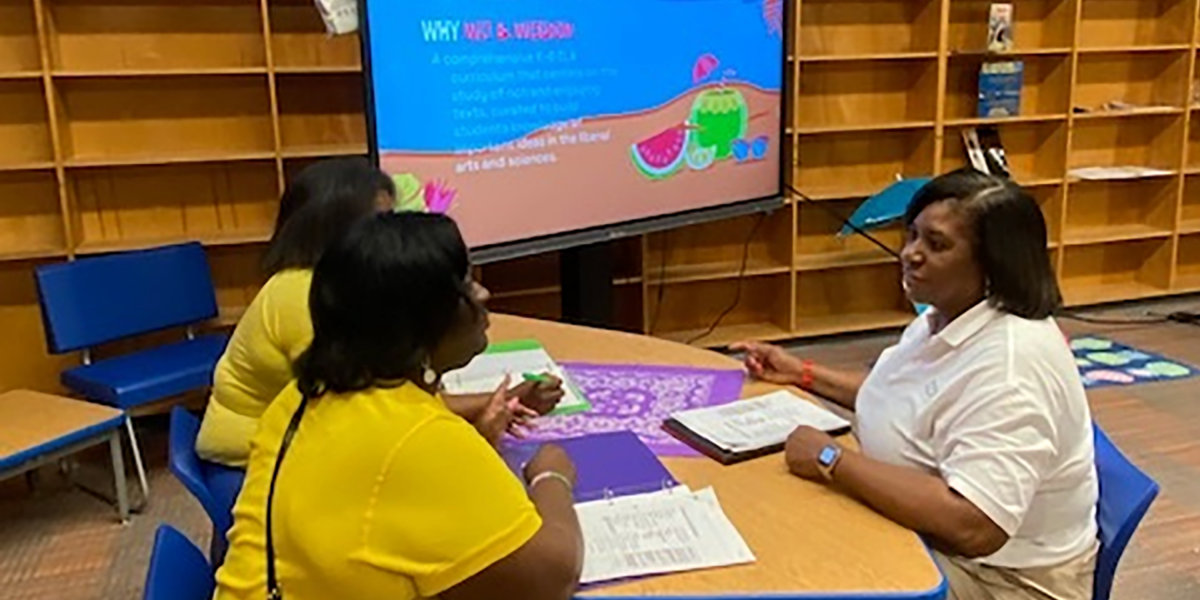How an Instructional Leadership Team Can Bring a New Curriculum to Life
July 14, 2022

As educators continue to address learning recovery and acceleration post-pandemic, there is little time to waste on irrelevant or disconnected lessons and content. To ensure that lessons are on grade-level and align with state standards, many districts have adopted high-quality curricula. The use of a high-quality curriculum can support educators to teach on grade-level and provide scaffolding supports for students who may be behind on state standards, yet only 40% of teachers in a recent survey reported that they were using curricula that are "high-quality and well aligned to learning standards."[1] Even when a high-quality curriculum is in place, researchers find that a lack of training and support often limits its use.
This is where the school instructional leadership team (ILT)—including administrators and teacher leaders in the building—plays a critical role. When set up effectively, the ILT can plan and deliver professional learning that is tailored to both teacher and student needs and provide high-impact classroom coaching that supports teachers to use the curriculum effectively.
Invest Time Upfront to Learn the Curriculum
Gaining a comprehensive understanding of the instructional materials is time-consuming work, and it requires ILT members to invest time upfront to learn the curriculum, how it connects to state standards, and how every teacher can bring it into their classroom. In addition to their regular meetings to address student learning, ILT members must understand the scope and sequence, layout, and decision points within the curriculum. Next, the ILT should take time to collaborate on ways that the materials can be embedded into professional learning and classroom coaching.
"We created a plan and a series of professional learning community (PLC) meetings on how to use the curriculum," said Dr. Casandra Jenkins, principal of Elloree Elementary School in South Carolina’s Orangeburg County School District. "We divided the curriculum components into small increments to help teachers understand it. The administrative team had to go first—we planned and taught lessons ourselves, breaking it into sections so that we could show teachers that it was doable. The teachers began to realize that we were right there, hand-in-hand, doing the work with them and that made a big difference."
When ILT members invest time to learn about the instructional materials, the culture around curriculum implementation improves. "What we did that was successful was to first share the big picture of what the curriculum encompasses, then we worked closely with teachers to break the curriculum down into small manageable pieces," said Dr. Jenkins. This high level of support by the leadership team helped teachers to see the value of the high-quality curriculum for addressing their students’ needs.
Using PLCs to Connect the “What” of the New Curriculum to the “How” of Teaching It
The ILT is a powerful tool in getting high-quality instructional materials used effectively in classrooms. NIET’s 2020 paper High-Quality Curriculum Implementation: Connecting What to Teach with How to Teach It describes how leaders can support teachers depending on where they are on the curriculum implementation progression – whether just learning the curriculum or at a point where they are deepening their understanding and skill in using the curriculum to support each learner.
"We created a plan and a series of PLCs on how to use the curriculum. We broke it into small pieces to help teachers understand it," said Dr. Jenkins. "We explained how the curriculum aligned to state standards, and then supported teachers to annotate their lessons for about 3-4 weeks, noting how a particular lesson could be delivered in their classroom." Once teachers saw how they could take a lesson plan and customize it to the needs of their children, how their own teaching practices would bring the lesson to life, they started to see how to use the curriculum each day to meet the needs of students.
Infuse Curriculum into Coaching and Feedback
Making the connections between professional learning during PLCs and implementation in classrooms is essential. "It was important for us to do a lot of check-ins through the process," said Dr. Jenkins. As a follow-up to PLC work, Dr. Jenkins and her team used walkthroughs to support teachers in their own classrooms. One important strategy was to help teachers make connections between high-quality instructional practices (described in the state’s teacher observation instrument, the South Carolina Teaching Standards 4.0) and the new content they were delivering in the classroom.
ILT members met weekly to ensure that their coaching was providing teachers with clear and consistent feedback targeted to where teachers are in curriculum implementation. It is not enough for ILT members to visit a classroom to confirm simply whether or not the curriculum is being used, they must use their own knowledge of the curriculum to connect their feedback to specific curriculum resources and lessons. By infusing curriculum into coaching and feedback moments—using a tool like the Teacher Learning Progression on Curriculum—ILT members can strengthen teachers’ understanding and use of a high-quality curriculum. This also makes clear that growth and improvement is a process and that leaders are invested in growing the skills and knowledge of each teacher.
The implementation of high-quality curricula is a powerful tool in increasing student achievement. Teachers, however, cannot be expected to master new and rigorous curriculum alone. ILT members are a key link in bringing a new curriculum to life for students by supporting and coaching teachers through curriculum implementation.
"We are seeing improvements and gains, and our next steps are to plan during the summer how to customize our lessons even more to meet each student’s needs," said Dr. Jenkins. "We had visitors come to our school recently and it was exciting to see the growth we have made progressing from no shared curriculum in use, to just starting implementation in the fall, to teachers speaking the language, and now students speaking the language of the curriculum."
[1] Educators for Excellence. Voices from the Classroom, 2020. e4e.org/teachersurvey.